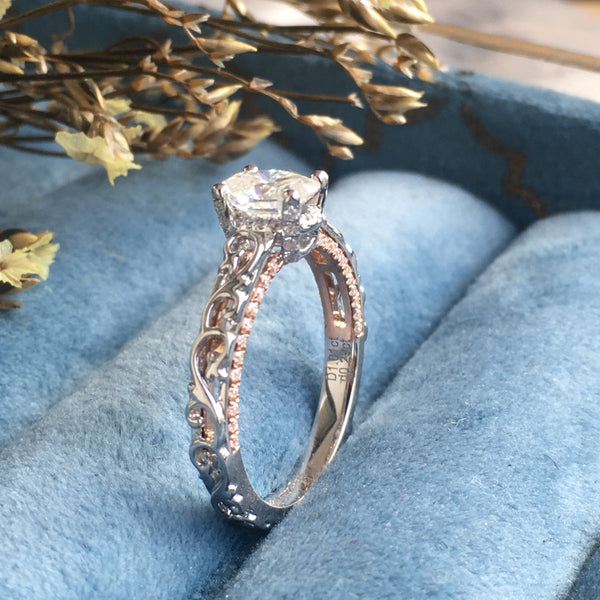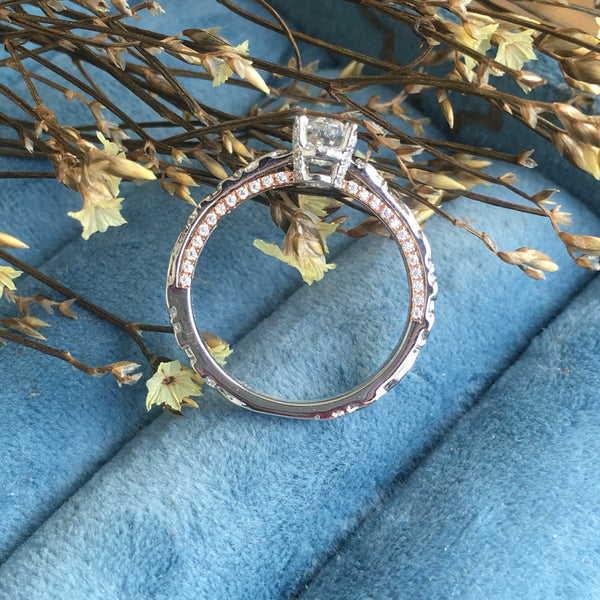The following article will give a topic by topic comparison of moissanite and diamonds. Both are made from naturally recurring minerals. The diamond is made from carbon and the moissanite is made from silicon carbide. Silicon carbide is an extremely natural recurring mineral where carbon is a little more common in nature. They are extremely different in their organic composition. Yet moissanite generally is cheaper in price than diamonds. But don’t be fooled by this because a gemstone may be cheaper in price but this does not mean it has more or less value than a gemstone that may be double the price.
Durability –Diamonds are the hardest gemstones known to man and moissanite are the second hardest gemstones known to man and are right behind diamonds on the durability scale. Another feature of moissanite is that it is more durable than other stones such as Sapphires, Rubies, or Emeralds which are very popular jewelry choices for people to purchase. People like to purchase moissanite as an alternative to diamonds because they will last for years and they are scratch resistant which many other gemstones are not as durable.
Moissanite is a very popular gemstone as well and it is much more durable than the above gemstones mentioned. They are also less expensive to purchase than these other stones. Because moissanite is so durable many people prefer to buy them over diamonds because they are as durable as diamonds. Its chemical formula is Silicone Carbide which is the same chemical formula used on bullet proof vests. To show just how durable moissanite is.
Carat-means— fruit of the carob tree—in ancient times the seeds of the carob were used as weights of measurements. The carat of the diamond is the weight and the heavier the diamond the more it will cost.
Moissanite are not priced like diamonds they are priced basically the same unless the stones are a different size or are made of enhanced or unenhanced materials. The enhanced will cost more than the unenhanced. But just because moissanite is generally priced lower than diamonds they are not any less valuable than diamonds are.
Color:
Diamonds are graded on a color scale—GIA Color Scale—but moissanite is not graded by color but they will reflect color nevertheless. They are not colorless and they do fall in the K scale of the GIA scale. This category says the stone will have a faint tint to it. So, moissanite can be made to reflect a faint color tint. Historically, moissanite have been made artificially to be colorless this giving the impression they are highly valuable as a colorless diamond. They were made to be slightly more colorless but they were not completely void of color because of technological limitations of making moissanite.
It is a known fact that moissanite is made to sparkle much more than a diamond and moissanite will reflect a rainbow of colors. In fact, if you were to put a diamond side by side to moissanite the moissanite will out sparkle the diamond by a noticeable amount. A moissanite will sparkle and reflect color twice as much as a diamond. This is called dispersion which gemologists define as the color reflection that a gemstone sparkles. Moissanite has a dispersion rate of 0.104 compared to a diamond’s dispersion rate of 0.044. This gives the moissanite double the dispersion rate of a diamond. Moissanite costs a fraction of the amount of a diamond.
Clarity:
Moissanite are graded on their blemishes or inclusions as diamonds are. Like diamonds moissanite will have imperfections in their structure that will be caught under magnification. Usually they will not be seen by the human eye. Their clarity will affect how much they cost. As diamonds will be priced on their grade of clarity. Both moissanite and diamonds will be priced on how clear they are. The fewer blemishes or inclusions either will have the higher priced they will be. If either has no defects or they can be hidden then the value of either will go up.
You need to know that unlike diamonds that are graded on clarity by the GIA moissanite is not graded by the GIA. They are individually graded by the manufacturer who made the moissanite. So, the clarity grading of moissanite will be more subjective than the clarity grading of diamonds.
Cuts:
Both moissanite and diamonds are made of several types of cuts such as cushion, round, pear, princess, and asscher cut. Note that moissanite are cut in antique cuts that diamonds were cut in hundreds of years ago. Here the comparison is fairly equal because both moissanite and diamonds are cut into several styles making both very valuable. It depends on what type of cut the customer prefers.
Today, a very popular cut for moissanite is known as the round brilliant cut. This cut is popular because it has such observable brilliance which will reflect the most color back to the human eye. The stone will sparkle if it is exposed to direct light. It also has brilliance and fire.
Another feature of the round brilliant cut is that it will hide color because the way it is cut. It will appear colorless and this really appeals to people these days. The cut is so versatile it will look good in rings and many other types of jewelry.
Resale Value: Both DovEggs and Amora offer appraisal services through NAGL—North American Gemological Lab. Both retailers will provide objective and fair appraisals of moissanite gemstones.
Specifically, DovEggs offers appraisal services for their moissanite gemstones through NAGL. They will offer objective and fair appraisal values for moissanite gemstones as was mentioned before. Contact both sellers and they will be glad to help you with your appraisal needs.
Conclusion: The article has covered a few key features of comparison between moissanite and diamonds. But keep in mind there are other factors to compare between the two when a person is considering purchasing moissanite or a diamond.



